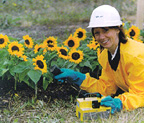

| |
||
| Marin Bjork, Laura Davis, Melissa Medeiros | ||
| Introduction | ||
 |
||
| Phytoremediation is a promising new green technology that uses plants’ nutritive and water needs to treat or stabilize contaminants from the soil or groundwater. It is an exciting new area of plant study and design that is moving away from the realm of engineers toward the multi-disciplinary approach of landscape architects. While biological and chemical engineers pursue solutions to large-scale or severe anthropogenic contamination of the landscape, this pursuit has the potential to take the field of landscape architecture back to its nineteenth-century roots in the issues of health, infrastructure, and open space. Urban landscapes have multiple spatial and functional objectives. The tools of phytoremediation can serve as a vocabulary of visible ecology function in urban places, expressing ongoing care and ecological health, as well as reminding us of our dependence on industrial technologies. |
||
Endophyte-assisted phytoremediation Introduction Certain endophytes can also increase plant resistance to drought and even Endophytes can be found throughout a plant: rhizosphere, roots, stem, or leaves |